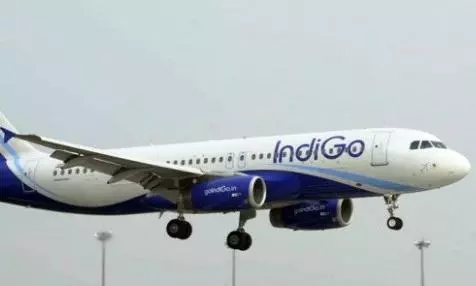In a shocking turn of events, an IndiGo flight from Hyderabad to Chandigarh was subjected to a bomb threat on the heels of a similar scare involving a Vistara flight. The back-to-back threats have sent ripples of concern across India, sparking worries about the increasing number of threats to air travel.
The IndiGo flight, scheduled to depart from Hyderabad’s Rajiv Gandhi International Airport for Chandigarh, was delayed after the authorities were alerted to the bomb threat. Security measures were swiftly implemented, and all passengers were evacuated, triggering hours of panic and tension at the airport.
But is India’s aviation industry witnessing a rise in threats? And are our security measures equipped to handle such situations?

Details of the Bomb Threat: What Happened on the IndiGo Flight?
According to early reports, the IndiGo flight from Hyderabad to Chandigarh was minutes from boarding when the bomb threat was received. Following the standard operating procedure, security personnel were immediately informed, and the flight was grounded for a thorough investigation.
What exactly happened?
- Emergency Protocols Triggered: IndiGo’s ground staff acted swiftly after receiving the threat, and the Central Industrial Security Force (CISF) took over, launching a full-scale investigation.
- Passengers Evacuated: As part of precautionary measures, all passengers were evacuated and moved to a safe distance while the aircraft underwent an intensive security check.
- Bomb Disposal Squad Deployed: The bomb disposal squad was called in to investigate any potential explosives on the plane. Luggage and cargo were also scanned thoroughly.
The CISF confirmed that no suspicious material was found onboard the IndiGo flight, and authorities later termed the threat a hoax. However, the scare caused massive disruptions at the airport, delaying other flights as well.
The Second Bomb Threat in Days: Are Airlines Being Targeted?
This bomb threat comes just days after a similar incident involving a Vistara flight, where a call claimed that a bomb had been planted on one of its flights. Fortunately, that too turned out to be a hoax, but it raises a worrying question: Are these threats random, or is there a coordinated effort to target Indian airlines?
While hoax threats may seem like mere pranks, they pose serious challenges:
- Disruption of Services: Bomb threats, whether real or fake, cause immense disruption to airlines, airports, and passengers. Flights are delayed, rerouted, and sometimes canceled altogether, leading to heavy financial losses for airlines.
- Passenger Safety at Risk: Even in hoax situations, passenger safety is of utmost concern. Airlines are compelled to evacuate planes and follow rigorous security protocols to ensure there are no real threats.
- Heightened Security Concerns: The increasing frequency of such threats is a grim reminder of the vulnerabilities within the aviation system. It compels authorities to ramp up security and review existing protocols to address any gaps.
Aviation Security in India: Is It Enough?
As incidents like these continue to grab headlines, many are left questioning the effectiveness of aviation security in India. While India’s airports are generally well-equipped to handle threats, frequent bomb scares may indicate weaknesses that need to be addressed.
Are Security Measures Sufficient?
- CISF and Bomb Disposal Units: While the Central Industrial Security Force (CISF) is responsible for securing India’s airports, it must now adapt to the new-age challenges of cyber and bomb threats. Increased collaboration between aviation authorities and intelligence agencies is essential to preempt such incidents.
- Passenger Vigilance: Authorities are urging passengers to be more vigilant and report any suspicious activity at airports or onboard flights. But is this enough?
- Psychological Impact: Passengers who experience these threats—hoax or real—can face long-term psychological distress, which may lead them to reconsider air travel altogether. The government must ensure that airports provide sufficient support and counseling in such cases.
What Are the Legal Repercussions for Bomb Threats?
The culprits behind bomb threats—whether hoaxers or real attackers—are subject to strict legal actions under India’s Anti-Hijacking Act, 2016. Those found guilty of making a bomb threat face:
- Fines: In cases of hoax bomb threats, fines can be levied against the perpetrator for wasting public resources and causing unnecessary panic.
- Imprisonment: Depending on the severity of the threat, individuals can face imprisonment of up to 10 years for hoax calls. For actual threats, punishments can extend to life imprisonment or even the death penalty if lives are endangered.
What Does This Mean for Passengers?
The increasing number of bomb threats, though mostly hoaxes, puts passengers in a state of unease. With the IndiGo flight from Hyderabad to Chandigarh being the latest in a string of threats, people are now questioning the security of Indian air travel.
- Increased Wait Times: Passengers can expect longer wait times for check-ins and security clearances as authorities strengthen their procedures.
- Heightened Security Checks: Random security checks, stricter baggage scanning, and more thorough checks at boarding gates could soon become the norm.
- Mental Stress: The threat of bomb scares—hoax or real—adds stress for passengers, many of whom may feel unsafe about flying in the current environment.
Is India’s Aviation Sector Under Threat?
As IndiGo and Vistara deal with the after-effects of these bomb threats, one question looms large: Is India’s aviation sector facing a growing threat of disruption? While these incidents have so far been hoaxes, they pose a serious challenge for India’s aviation authorities and raise critical concerns over safety.
Moving forward, the focus must be on fortifying security, introducing preventive measures, and reassuring passengers that flying remains safe in India. As the aviation industry recovers from the pandemic, the last thing it needs is to lose the confidence of its customers due to bomb scares and safety concerns.

